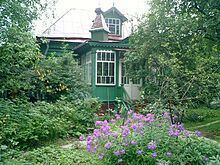Coat of arms of Malakhovka Flag of Malakhovka Local time Sunday 3:29 AM | Anthem Anthem of Malakhovka Area 16.35 km² | |
 | ||
Municipal district Lyuberetsky Municipal District Weather 2°C, Wind S at 29 km/h, 81% Humidity | ||
Malakhovka (Russian: Мала́ховка), a Moscow suburb with historic dachas, is an urban locality (a work settlement) in Lyuberetsky District of Moscow Oblast, Russia. Population: 24,004 (2010 Census); 18,552 (2002 Census); 26,454 (1989 Census).
Contents
- Map of Malakhovka Moskovsky Russia
- History
- Administrative and municipal status
- Economy and infrastructure
- Media
- Notable people
- References
Map of Malakhovka, Moskovsky, Russia
History
Under the name Malakhovskoye (Мала́ховское), it was first mentioned in 1328 in Ivan Kalita's will as a place left to Ivan's older son Semyon.
The railway station was built in 1884, and by the next year Malakhovka was recognized as a dacha settlement. By the end of the 19th century, the settlement was inhabited by such renowned representatives of Russian arts and literature as Anton Chekhov, Maxim Gorky, Ivan Bunin, and Feodor Chaliapin. Chaliapin performed in the Summer Theater before 1914. The actress Faina Ranevskaya performed there from the following year, and also had a dacha there. At the time of the Revolution Malakhovka was a described as a "hamlet" of about three hundred dachas.
Urban-type settlement status was granted to Malakhovka in 1961.
Administrative and municipal status
Within the framework of administrative divisions, Malakhovka is incorporated within Lyuberetsky District of Moscow Oblast. Within the framework of municipal divisions, Malakhovka is a part of a larger Malakhovka Urban Settlement, which, in addition to Malakhovka proper, also includes the village of Pekhorka and adjacent territories.
Economy and infrastructure
The Malakhovka railway station is located 29 kilometers (18 mi) southeast from Moscow. The settlement has minor industry: an ore mining equipment factory and a food processing plant. There are also two sanatoriums, a history museum, an Orthodox church, and a synagogue.
Media
Malakhovka has a local newspaper, Malakhovsky Vestnik (Малаховский Вестник, "Malakhovka Herald").
Notable people
Marc Chagall taught at a Jewish boys shelter (mainly for refugees from Ukrainian pogroms) here in 1921, did the illustrations for David Hofstein's long poem "Troyer" (Grief) and worked on his mural "Introduction to the Jewish Theater". The refuge was a center for many Yiddish writers including Der Nister, who lived with Chagall, David Hofstein, Moshe Lifshits and Itzik Feffer.
The Soviet writer and USSR State Prize Laureate Nikolay Dobronravov (husband of Aleksandra Pakhmutova) went to school in Malakhovka during the war. The Olympic and World champion runner Irina Privalova was born in Malakhovka.
An early (1959) poem by Andrey Voznesensky is "Last Train to Malakhovka", regarding his regular trips to the settlement.
